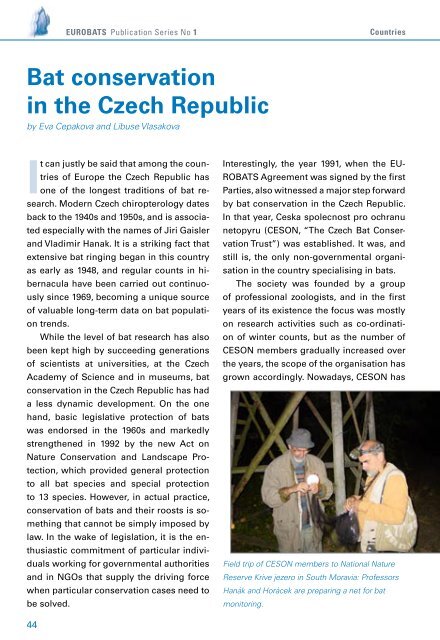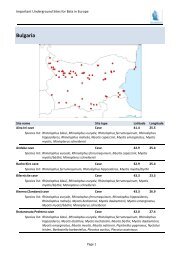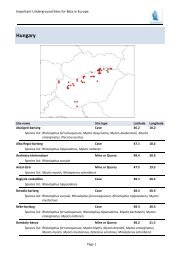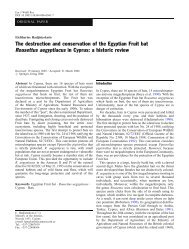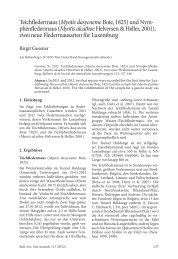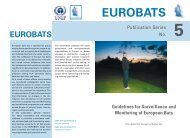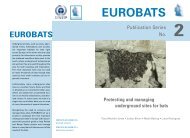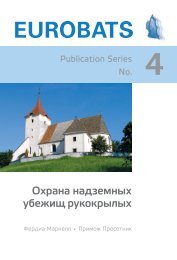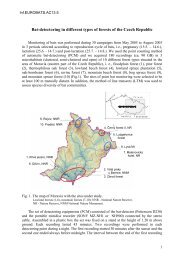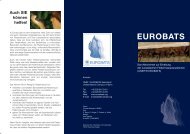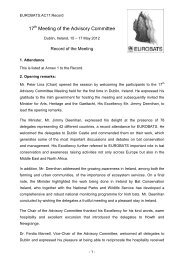1991 - 2006. EUROBATS celebrates its 15th anniversary
1991 - 2006. EUROBATS celebrates its 15th anniversary
1991 - 2006. EUROBATS celebrates its 15th anniversary
You also want an ePaper? Increase the reach of your titles
YUMPU automatically turns print PDFs into web optimized ePapers that Google loves.
44<br />
<strong>EUROBATS</strong> Publication Series No 1 Countries<br />
Bat conservation<br />
in the Czech Republic<br />
by Eva Cepakova and Libuse Vlasakova<br />
It can justly be said that among the coun-<br />
tries of Europe the Czech Republic has<br />
one of the longest traditions of bat re-<br />
search. Modern Czech chiropterology dates<br />
back to the 1940s and 19 0s, and is associated<br />
especially with the names of Jiri Gaisler<br />
and Vladimir Hanak. It is a striking fact that<br />
extensive bat ringing began in this country<br />
as early as 1948, and regular counts in hibernacula<br />
have been carried out continuously<br />
since 1969, becoming a unique source<br />
of valuable long-term data on bat population<br />
trends.<br />
While the level of bat research has also<br />
been kept high by succeeding generations<br />
of scientists at universities, at the Czech<br />
Academy of Science and in museums, bat<br />
conservation in the Czech Republic has had<br />
a less dynamic development. On the one<br />
hand, basic legislative protection of bats<br />
was endorsed in the 1960s and markedly<br />
strengthened in 1992 by the new Act on<br />
Nature Conservation and Landscape Protection,<br />
which provided general protection<br />
to all bat species and special protection<br />
to 13 species. However, in actual practice,<br />
conservation of bats and their roosts is something<br />
that cannot be simply imposed by<br />
law. In the wake of legislation, it is the enthusiastic<br />
commitment of particular individuals<br />
working for governmental authorities<br />
and in NGOs that supply the driving force<br />
when particular conservation cases need to<br />
be solved.<br />
Interestingly, the year <strong>1991</strong>, when the EU-<br />
ROBATS Agreement was signed by the first<br />
Parties, also witnessed a major step forward<br />
by bat conservation in the Czech Republic.<br />
In that year, Ceska spolecnost pro ochranu<br />
netopyru (CESON, “The Czech Bat Conservation<br />
Trust”) was established. It was, and<br />
still is, the only non-governmental organisation<br />
in the country specialising in bats.<br />
The society was founded by a group<br />
of professional zoologists, and in the first<br />
years of <strong>its</strong> existence the focus was mostly<br />
on research activities such as co-ordination<br />
of winter counts, but as the number of<br />
CESON members gradually increased over<br />
the years, the scope of the organisation has<br />
grown accordingly. Nowadays, CESON has<br />
Field trip of CESON members to National Nature<br />
Reserve Krive jezero in South Moravia: Professors<br />
Hanák and Horácek are preparing a net for bat<br />
monitoring.


